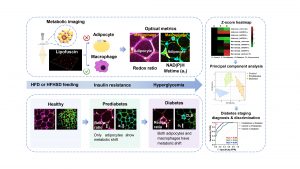A research team led by Liu Tzu-Ming, associate professor in the Faculty of Health Sciences (FHS) at the University of Macau (UM), has developed a technique for prediabetes detection based on metabolic fluorescence imaging of adipose tissue. The study presents an innovative method for diagnosing prediabetes, shedding light on diabetes prevention strategies. The research results have been published in the international journal Theranostics.
Prediabetes can be reversed through lifestyle intervention, but its main pathologic hallmark, insulin resistance (IR), cannot be detected as conveniently as blood glucose testing. In consequence, the diagnosis of prediabetes is often delayed until patients have hyperglycemia. Therefore, developing a less invasive diagnostic method for rapid IR evaluation will contribute to the screening and prevention of prediabetes. Since adipose tissue is an endocrine organ that plays a crucial role in the development and progression of prediabetes, metabolic fluorescence imaging the prediabetic microenvironment of adipose tissues provides a less invasive alternative for the characterisation of IR and inflammatory pathology.
The research team successfully identified the differentiable features of prediabetic adipose tissues by employing the metabolic imaging of three endogenous fluorophores NAD(P)H, FAD, and lipofuscin pigments. 1040-nm excited lipofuscin autofluorescence could mark the location of macrophages. This unique feature helps distinguish the metabolic fluorescence signals of macrophages from those of adipocytes. In prediabetes fat tissues with IR, only adipocytes exhibit a low redox ratio of metabolic fluorescence and high free NAD(P)H fraction a1. This differential signature disappears in mice which quit the high-fat diet or high-fat-high-sucrose diet and recover from IR. When mice have diabetic hyperglycemia and inflamed fat tissues, both adipocytes and macrophages possess such kind of metabolic change. As confirmed with RNA-seq analysis and histopathology evidence, the change in adipocyte’s metabolic fluorescence could be an indicator or risk factor of prediabetic IR.
Prof Liu is the corresponding author of the study, and his PhD student Chen Liping is the first author. Others who have contributed to the study include PhD student Qin Guihui and postdoctoral fellow Wang Xiaoyan in the FHS. The project was supported by the Science and Technology Development Fund of the Macao SAR (File no: 122/2016/A3, 018/2017/A1, 0120/2020/A3, 0026/2021/A) and UM (File no: MYRG2018-00070-FHS, MYRG-CRG2022-00009-FHS). The full version of the research article can be viewed at https://www.thno.org/v13p3550.htm.
| Source: Faculty of Health Sciences | |
| Media Contact Information: | |
| Communications Office, University of Macau | |
| Albee Lei | Tel: (853) 8822 8004 |
| Bell Leong | Tel: (853) 8822 8009 |
| Email: | prs.media@um.edu.mo |

